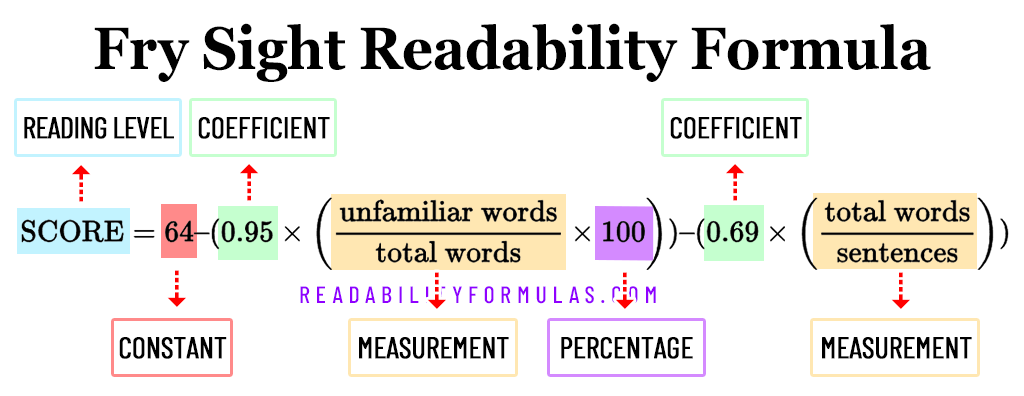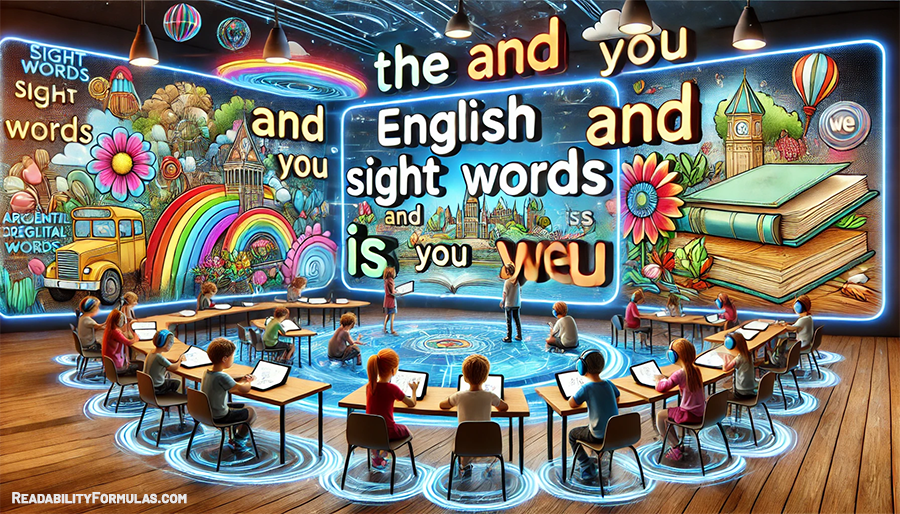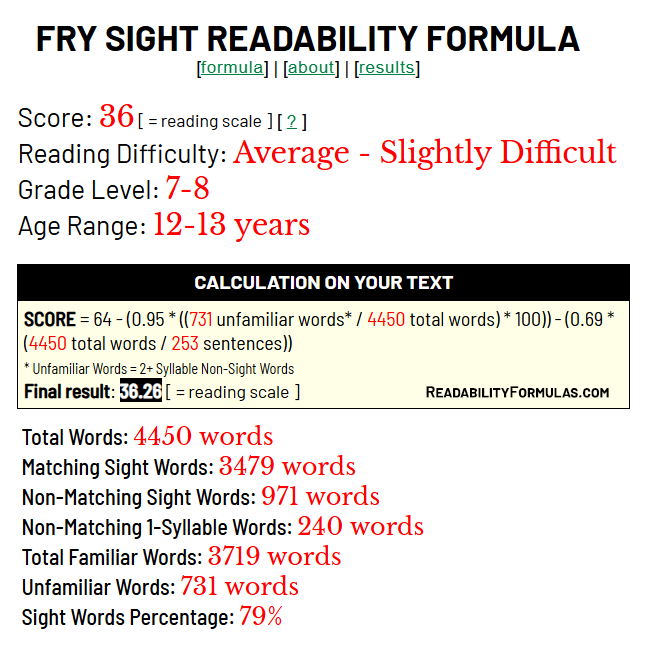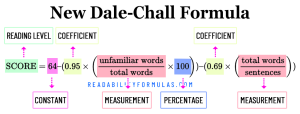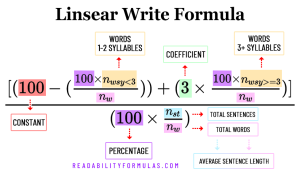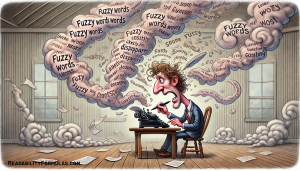The Fry Sight Readability Formula (not to be confused with The Fry Graph) analyzes the frequency of sight words, syllable complexity, and sentence length to measure text difficulty.
The formula uses the Dale-Chall formula as the blueprint for its calculations:
\[
\text{SCORE} = 64 – (0.95 \times \left( \frac{\text{unfamiliar words}}{\text{total words}} \times 100 \right)) – (0.69 \times \left( \frac{\text{total words}}{\text{sentences}} \right))
\]
Where:
- Unfamiliar Words are defined as 2+ syllable non-sight words.
- Total Words is the total number of words in the text.
- Sentences is the number of sentences in the text.
Familiar words are all sight words and 1-syllable words in the user’s text.
The formula uses specific constants to calculate a readability score. Here’s an explanation of the numbers:
- 64: This is the base score from which the formula subtracts points. It represents an initial high readability score (very easy to read). A higher starting point allows it to measure a range of readability levels, from very easy to very difficult. This base score is based on empirical data and readability studies, ensuring the formula provides a meaningful and scaled measurement of readability.
- 0.95: This multiplier adjusts the percentage weight of difficult words. A higher multiplier increases the impact of difficult words on the readability score. The value 0.95 is to balance the impact of word difficulty and sentence complexity.
- 100: This converts the fraction of difficult words into a percentage.
- 0.69: This multiplier adjusts the ASL weight (average sentence length). It reflects how much sentence length contributes to text difficulty. This multiplier reduces the score based on the average sentence length, reflecting the difficulty of processing longer, more complex sentences.
- ASL (Average Sentence Length): This is the average number of words per sentence in the text. Longer sentences indicate more complex syntax.
The final score is matched to the New Dale-Chall/Bormuth reading scale:
| Bormuth/Dale-Chall Reading Scale | ||||
|---|---|---|---|---|
| Score Range | Difficulty | Age | Grade | Grade Range |
| 58+ | Extremely Easy | 5-6 years | 1 | 1 |
| 57 – 54 | Very Easy | 7 years | 2 | 2 |
| 53 – 50 | Fairly Easy | 8 years | 3 | 3 |
| 49 – 45 | Easy | 9 years | 4 | 4 |
| 44 – 40 | Average | 10-11 years | 5-6 | 5.5 |
| 39 – 34 | Average – Slightly Difficult | 12-13 years | 7-8 | 7.5 |
| 33 – 28 | Slightly Difficult | 14-15 years | 9-10 | 9.5 |
| 27 – 22 | Fairly Difficult | 16-17 years | 11-12 | 11.5 |
| 21 – 16 | Difficult | 13 – 15 years | College Student | 14 |
| 15 – | Very Difficult | 18+ | College Graduate | 16 |
The Fry Sight Readability Formula is grounded in the principles of sight word frequency and syllable complexity. Here’s why it works:
High-Frequency Words: The Fry sight words list has 1,000 of the most commonly-used words in English. The first 300 words in the list account for 65% of all the words readers will encounter in their reading. These words are essential for fluent reading in both easy and advanced texts.
Identification of Unfamiliar Words: The formula differentiates between familiar sight words and unfamiliar words. Unfamiliar words are those that have two or more syllables and are not part of the Fry sight words list. These words are more challenging for readers to decode and understand, thus increasing the text’s complexity.
Syllable Complexity: Words with more syllables are more difficult for readers to decode and comprehend. Identifying and counting these unfamiliar, multi-syllable words can measure the text’s complexity.
Sentence Length: Longer sentences can be more challenging to read and understand, especially for young readers. Using the total number of words per sentence measures syntactic complexity.
Sight Words: Texts with more sight words will have fewer complex words, scoring a higher readability (indicating easier text).
Unfamiliar Words: Texts with many unfamiliar words will lower the score, indicating a more difficult text.
Sight Words as a Readability Word List
Sight words, also known as high-frequency words, are the words that readers see most often in written language. Because of their high occurrence, learning sight words improves reading fluency. These words escape regular phonetic patterns, making them difficult for young readers to decode using standard phonics rules. Instead, readers learn them through memorization.
The Fry sight words are designed to cover most words readers will encounter in any text. The first 100 Fry sight words alone account for approximately 50% of all words in reading materials. As we expand to 300 words, they cover about 65% of all words in written texts. In more detail:
First 100 Fry Sight Words: These words comprise 50% of the words in any text. They are the most frequently occurring words. Readers must know them for basic reading. These include basic and common words such as “the,” “of,” “and,” “a,” “to,” “in,” “is,” “you,” “that,” “it.” These words form the backbone of most simple sentences .
First 200 Fry Sight Words: The next 100 words comprise 60% of the words readers will encounter in most texts. This set includes a broader range of common words. Adding another 100 words, we get words like “over,” “new,” “sound,” “take,” “only,” “little,” “work,” “know,” “place,” “year.” These words appear frequently in more complex sentences and are still quite common in everyday language.
First 300 Fry Sight Words: The next 100 words cover 65% of all words in written texts. This expanded set includes additional high-frequency words that improve reading fluency and comprehension. Expanding to 300 words includes “live,” “me,” “back,” “give,” “most,” “very,” “after,” “thing,” “our,” “just.” These words enrich the vocabulary needed for fluent reading.
Fry’s 1,000 most common words turn up 80 percent of the time in texts.
Influence on Readability
- Reading Fluency: When readers recognize sight words without needing to decode them, they speed up their reading process. This fluent reading helps them understand the text more easily.
- Text Complexity: Texts with more sight words are easier to read because they need less effort to decode. This reduces cognitive load, and helps readers who are still developing their reading skills.
- Confidence Building: Encountering familiar sight words in texts boosts readers’ confidence, encouraging them to read more. This positive reinforcement helps readers to advance their reading skills quickly.
The Fry Sight Words Formula has been tested on numerous grade-level texts as well as validated with results of other readability formulas. The results of one such test, on The Great Gatsby, show the accuracy with other formulas on the same text.
Sample Text: The Great Gatsby
Your text (truncated): My family have been prominent, well-to-do people in this Middle Western city for three generations. The Carraways are something of a clan, and we have a tradition that we’re descended from the Dukes of Buccleuch, but the actual founder of my line was my grandfather’s brother, who came here in…
==============================================
AVERAGE READING LEVEL CONSENSUS
The average public reading level in the U.S. is 8th grade. Based on 10 formula(s), your text scored the following:
Score: 7.94 ( = grade level )
U.S. Grade Level: 8th Grade
Reading Level: Average – Slightly Difficult
Age Range: 13-14
==============================================
AUTOMATED READABILITY INDEX
Score: 8.60 ( = grade level )
Reading Difficulty: Slightly Difficult
Grade Level: 9th Grade
Age Range: 14-15
CALCULATION ON YOUR TEXT
ARI = (4.71 * ( 20066 characters / 4450 words)) + (0.5 * (4450 words / 253 sentences)) – 21.43
Final result: 8.60
==============================================
FLESCH READING EASE
Score: 71.00 ( = reading scale )
Reading Difficulty: Fairly Easy
Grade Level: 7th Grade
Age Range: 12-13 years old
CALCULATION ON YOUR TEXT
206.835 – (1.015 * (4450 words / 253 sentences)) – (84.6 * 6251 syllables / 4450 words)
Final result: 71.00
==============================================
GUNNING FOG READABILITY
Score: 8.20 ( = grade level )
Reading Difficulty: Average – Slightly Difficult
Grade Level: 8th Grade
Age Range: 13-14
CALCULATION ON YOUR TEXT
FOG = (0.4 * (4450 words / (253 sentences + 98 compound sentences)) + 100 * (347 FOG hard words / 4450 words))
Final result: 8.20
==============================================
FLESCH-KINCAID GRADE LEVEL
Score: 7.85 ( = grade level )
Reading Difficulty: Average – Slightly Difficult
Grade Level: 8th Grade
Age Range: 13-14
CALCULATION ON YOUR TEXT
SCORE = (0.39 * (4450 words / 253 sentences)) + (11.8 * (6251 syllables / 4450 words)) – 15.59
Final result: 7.85
==============================================
COLEMAN-LIAU READABILITY INDEX
Score: 7.75 ( = grade level )
Reading Difficulty: Average – Slightly Difficult
Grade Level: 8th Grade
Age Range: 13-14
CALCULATION ON YOUR TEXT
SCORE = (0.0588 * (19096 letters / 4450 words) * 100) – (0.296 * (253 sentences / 4450 words) * 100) – 15.8
Final result: 7.75
==============================================
SMOG INDEX READABILITY SCORE
Score: 7.26 ( = grade level )
Reading Difficulty: Average
Grade Level: 7th Grade
Age Range: 12-13
CALCULATION ON YOUR TEXT
SCORE = 1.043 * Sqrt((382 hard words * (30 / 253 sentences)) + 3.1291)
Final result: 7.26
==============================================
LINSEAR WRITE READABILITY FORMULA
Score: 8.40 ( = grade level )
Reading Difficulty: Average – Slightly Difficult
Grade Level: 8th Grade
Age Range: 13-14
CALCULATION ON YOUR TEXT
Initial Score = (((4064 easy words – 324 ignored words) * 1) + (382 hard words * 3)) / (253 sentences + 7 compound sentences
Adjusted Score = (18.79 (initial score) – 2) / 2
Final result: 8.40
==============================================
THE NEW DALE-CHALL READABILITY FORMULA
Score: 38 ( = reading scale )
Reading Difficulty: Average – Slightly Difficult
Grade Level: 7-8
Age Range: 12-13 years
CALCULATION ON YOUR TEXT
64 – (0.95 * ((636 hard words / 4450 total words) * 100)) – (0.69 * (4450 total words / 253 sentences))
Final result: 38.29
==============================================
[ORIGINAL] DALE-CHALL READABILITY FORMULA
Score: 3.13 ( = grade level )
Adjusted Score: 3.6365 + 3.13 = 6.77 ( = grade level )
(Adjusted) Grade Level: Grades 7-8
Reading Difficulty: Average
Age Range: 12-13
CALCULATION ON YOUR TEXT
0.1579 * ((636 hard words / 4450 total words) * 100) + 0.0496 * (4450 total words / 253 sentences) + 3.6365
Final result: 6.77
Dale-Chall Word Stats:
Number of words in your text: 4450 words
Number of words not found on Dale-Chall list: 636 words
Percentage of words not found on Dale-Chall list: 14%
==============================================
FRY SIGHT READABILITY FORMULA
Score: 36 ( = reading scale )
Reading Difficulty: Average – Slightly Difficult
Grade Level: 7-8
Age Range: 12-13 years
CALCULATION ON YOUR TEXT
SCORE = 64 – (0.95 * ((731 unfamiliar words* / 4450 total words) * 100)) – (0.69 * (4450 total words / 253 sentences))
* Unfamiliar Words = 2+ Syllable Non-Sight Words
Final result: 36.26 [ = reading scale ]
Total Words: 4450 words
Matching Sight Words: 3479 words
Familiar Words: 3173 words
Non-Matching Sight Words: 971 words
Sight Words Percentage: 79%
==============================================
Results calculated on 7/25/2024 at 1:09:03 PM by ReadabilityFormulas.com
The Fry Sight Readability Formula will be available December 2024.
Scott, Brian. “The Fry Sight Readability Formula to Measure Text Complexity.” ReadabilityFormulas.com, 25 Jan. 2025, https://readabilityformulas.com/the-fry-sight-readability-formula-to-measure-text-complexity/.

